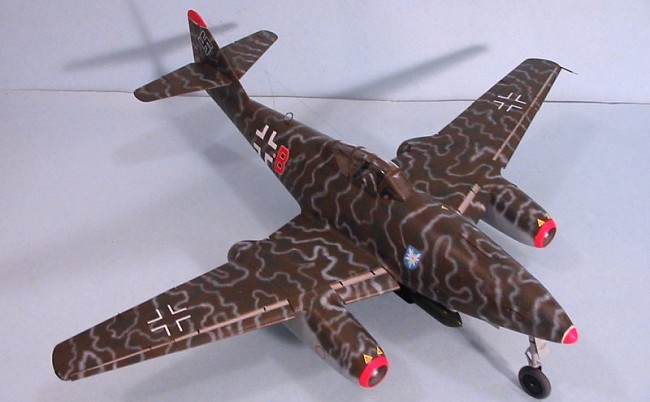
| KIT: | Trumpeter 1/32 Me-262A-1/2 |
| KIT #: | 02235/6 |
| PRICE: | $69.95 MSRP |
| DECALS: | Two options |
| REVIEWER: | Tom Cleaver |
| NOTES: |

| HISTORY |
Reading the history of the Messerschmitt Me-262 - the world's first operational jet fighter - one can only conclude that if World War II had to be fought, we were fortunate to have a moron like Adolf Hitler for an opponent. Had anyone else been in charge, we might well all be speaking German (any study of the relevant history will reveal, however, that the only person on the planet who wanted World War II was Hitler).
Following the victories in the West in 1940, the idiots of the Reichluftfartministerium determined that any project not capable of coming to fruition within 18 months would be scrapped. This effectively put the entire German jet fighter program on hold, to the ultimate benefit of the Allies when not one German jet aircraft reached operational effectiveness in worthwhile numbers. This was particularly fortunate when one compares the performance of the Me-262 with the Meteor I and III, the only Allied jet fighter that could have opposed it, had it reached operational units in early 1944 as Adolf Galland believed it could have been; that it did not was due to the other "command decision" - Supreme Dummkopf Hitler's determination in the fall of 1943 that the airplane should be produced as a bomber.
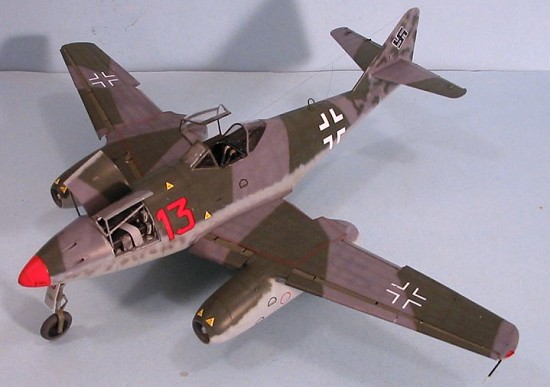 In an interview, Galland stated, "I believe the Me-262 could have been made
operational as a fighter at least a year and a half earlier, and built in
large enough numbers so that it could have changed the air war. It would
most certainly not have changed the final outcome of the war, for we had
already lost completely, but it would have probably delayed the end, since
the Normandy invasion on June 6, 1944, would probably not have taken place,
at least not successfully if the 262 had been operational. I certainly
think that just 300 jets flown daily by the best fighter pilots would have
had a major impact on the course of the air war."
In an interview, Galland stated, "I believe the Me-262 could have been made
operational as a fighter at least a year and a half earlier, and built in
large enough numbers so that it could have changed the air war. It would
most certainly not have changed the final outcome of the war, for we had
already lost completely, but it would have probably delayed the end, since
the Normandy invasion on June 6, 1944, would probably not have taken place,
at least not successfully if the 262 had been operational. I certainly
think that just 300 jets flown daily by the best fighter pilots would have
had a major impact on the course of the air war."
As it was, even with the full panoply of official Nazi mendacity arrayed against it, the Me-262 did reach initial operational capability in the summer of 1944, and gave Allied air force commanders fits from the day a Mosquito crew reported evading one, right up to V-E day.
An idea of how effective the airplane could be against its Allied opposition can be seen in the career of Major Kurt Welter, the top-scoring Wilde Sau pilot with 30 victories by the end of 1944, who began using the Me-262 in the wilde sau role in January 1945; the first time he flew the Me-262 at night over Berlin, he shot down four Mosquitos in one mission. By the end of April he had shot down an estimated 20+ British bombers - almost all Mosquitos, which before then had been virtually immune to interception by German piston-engine fighters; this makes Welter - not Heinz Bar - the top-scoring jet fighter pilot of the war, as well as the second-highest scoring jet ace of history, behind only Col. Yevgeny Pepelyaev of the VVS-PVO in Korea (21 victories). Several other members of Kommando Welter scored well against the Mosquitos of the Light Night Striking Force during the seven weeks the unit saw combat during March and April 1945, prompting Bomber Command to send a huge raid against their base at Magdeburg on Easter Sunday, 1945.
1,420 Me-262s of all variants were produced by the end of the war. Fortunately for history, the words that best describe this technological wonder are "too little, too late."
I am fortunate to know two men who flew the Me-262 in combat. Their memories of the airplane are very interesting for anyone interested in aviation history.
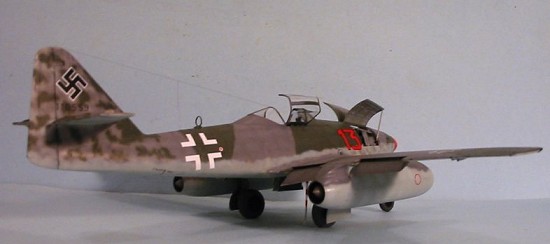 The ranks of "Great Luftwaffe Aces" do not include Leutnant Jorg
Czypionka. "You have to understand," he explains, "I joined the Luftwaffe
because I loved airplanes and flying, not for the combat. All the choices I
made about assignments, I thought first of how much skill it would take to
do it, how much I could learn about flying if I did it. I was really just
one of those who served." However, Czypionka is now the only surviving
pilot of Kommando Welter, a unit whose name is well-known to
students of the Second World War Luftwaffe, but about whose
operations little is known; thus, his memories are important.
The ranks of "Great Luftwaffe Aces" do not include Leutnant Jorg
Czypionka. "You have to understand," he explains, "I joined the Luftwaffe
because I loved airplanes and flying, not for the combat. All the choices I
made about assignments, I thought first of how much skill it would take to
do it, how much I could learn about flying if I did it. I was really just
one of those who served." However, Czypionka is now the only surviving
pilot of Kommando Welter, a unit whose name is well-known to
students of the Second World War Luftwaffe, but about whose
operations little is known; thus, his memories are important.
In 1945, when Kurt Welter began his battle with the Mosquito, no one thought it possible that a jet could be flown at night, or that a fighter without radar could accomplish such things. "Actually," Czypionka explains, "it really wasn't that hard to see them. The fires below would reflect on them, or if they were over clouds they would be silhouetted by the light of the searchlights, and there were the searchlights. Having an airplane that could catch up to them almost as soon as you saw them, that was what made it easy."
Even today, sixty years later, Czypionka's eyes light up when he recalls the first time he ever saw the Me-262. "It was absolutely breathtaking. It looked like it was going fast standing there! I looked at it and just knew I was looking at the future. I couldn't wait to get a chance to fly it."
When one thinks of what a technological advance the Me-262 was over everything that had come before, transitioning was almost off-hand as Czypionka recalls it. "I sat in the machine for an hour and memorized where everything was, how to operate the throttle controls. That was the really hard part, to operate the throttles right. If you operated the throttles too fast, they would flame out. It took both hands to work them, which was why people got in trouble if they had an engine problem while they were flying. You had to baby them. For me, I had been flying gliders and light planes for so long, I was used to controlling the airplane with my flight controls. So many other pilots, the ones who had a lot of time in high-powered machines, they were used to controlling the airplane with the throttle, and they were used to a throttle that reacted quickly. You really had to have a feel for it as a flying machine to have any real chance in it."
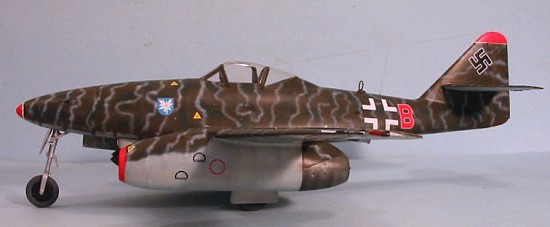 Jorg recalls his first flight, "It was the last light of day, already
toward sunset. It was hard to get the engines started, the mechanic had to
use these little two-cycle starter motors in each, and then you had to baby
the engine once it was started. But after I got the engines started, I
closed the hood and it was so silent! So smooth, no vibration at all. I
got out on the runway and applied power and it was so fast! Just straight
down the runway, I didn't have to touch the rudder pedals at all like with
every other airplane, and then I was off and climbing. It was the best
flight I ever had in an airplane. And then that night, after only that one
flight, I flew my first mission and got a Mosquito."
Jorg recalls his first flight, "It was the last light of day, already
toward sunset. It was hard to get the engines started, the mechanic had to
use these little two-cycle starter motors in each, and then you had to baby
the engine once it was started. But after I got the engines started, I
closed the hood and it was so silent! So smooth, no vibration at all. I
got out on the runway and applied power and it was so fast! Just straight
down the runway, I didn't have to touch the rudder pedals at all like with
every other airplane, and then I was off and climbing. It was the best
flight I ever had in an airplane. And then that night, after only that one
flight, I flew my first mission and got a Mosquito."
According to Czypionka, the Me-262 was not as hard to fly as reports say. "They told us to handle it carefully, and as long as you did things right it would not turn and bite you, but then we were young and wouldn't have cared even if it was more dangerous than it was. The main thing was, if you could fly it at all and get the enemy in the sights, you had them. The gun armament was fantastic. One burst was all it would take."
On one of his night intercept missions, Czypionka suffered a flameout while on landing approach. At an altitude of only 600 meters and low on fuel, he was able to get a re-light and make a successful landing from a situation that almost always led to a fatal crash with other pilots. "To tell you the truth, I can't remember exactly what I did," he remembers. "There was a procedure and I was very familiar with all the flight procedures for the airplane and I did it very quickly." It is stories like this that put a different take on Czypionka's modesty over his flying achievements, as he is perhaps the only Me-262 pilot to ever do this successfully, and certainly the only one to ever do it at night.
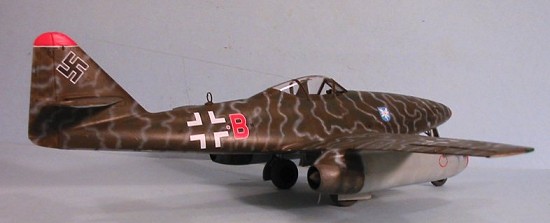 Hans Busch flew the Me-262A-2a with IV/KG 51, the first jagdbomber unit of
the Luftwaffe. Having joined the Luftwaffe in 1943 and being given the
full course of flight training, he was convinced by an instructor to
volunteer for multi-engine training, since it could lead to airline work
after the war. In the summer of 1944 he got his operational assignment -
KG 51, then flying the Ju-88. “Just what I didn’t want.” That June, the
unit was ordered to transfer to Bf-110s to become a night fighter unit, but
before more than a handful of pilots had transition to the 110, the unit
was ordered in August to become the first jet bomber unit.
Hans Busch flew the Me-262A-2a with IV/KG 51, the first jagdbomber unit of
the Luftwaffe. Having joined the Luftwaffe in 1943 and being given the
full course of flight training, he was convinced by an instructor to
volunteer for multi-engine training, since it could lead to airline work
after the war. In the summer of 1944 he got his operational assignment -
KG 51, then flying the Ju-88. “Just what I didn’t want.” That June, the
unit was ordered to transfer to Bf-110s to become a night fighter unit, but
before more than a handful of pilots had transition to the 110, the unit
was ordered in August to become the first jet bomber unit.
Once checked out in the Me-110, the unit flew the Fw-190, to get used to flying a high-performance single-seater. “I loved the 190, its performance was just beautiful. Flying aerobatics in it was marvelous.” Flying the Fw-190 wasn’t all about the joy of flying however. “We were flying them in order to train for the kind of bombing attack we would make. The Me-262 had no dive brakes or any other way of slowing its flight other than to work the throttles, which you couldn’t do. There was no way we could dive-bomb a target, since the speed would build up too fast to allow us to pull out safely.”
Instead, KG 51 developed a gentle, 15-degree dive, which would give sufficient speed to evade the defenses, while still maintaining control. “The problem was, we didn’t have any bomb sight but the gunsight. If you could dive-bomb, you could do it with the gunsight, but all we could do was to drop the bomb as a guess when we approached the target. With enough practice, you could make a pretty good guess, but a good guess isn’t how you hit a target when you only have the one chance with two 250kg bombs.” When KG 51 was committed to combat in the late winter of 1945, they scored badly attacking British airfields in Holland, and against the Ludendorff Bridge when it was captured in March. “In fact, those raids the groups did manage to accomplish were just pinpricks, particularly when you compare what we could do with what could be done with a thousand bombers flying over a target.”
Busch and the others finally met the Me-262 when they moved to Neuburg on
the Danube. “It was beautiful. It looked like nothing else any of us had
ever seen, like something from the future.” Since there were no two-seat
conversion trainers, initial training constituted familiarization. “The
‘flight instructors’ were guys who had done it ahead of. You sat in the
cockpit 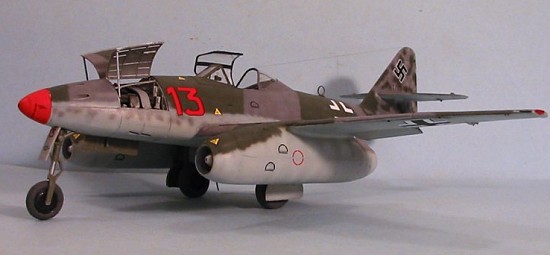 and memorized where everything was, what you had to do for various
procedures to operate the machine. When you could sit in the cockpit
blindfolded and find everything, and clearly explain every procedure and
move the control to accomplish them while blindfolded, you were considered
ready to try a flight.”
and memorized where everything was, what you had to do for various
procedures to operate the machine. When you could sit in the cockpit
blindfolded and find everything, and clearly explain every procedure and
move the control to accomplish them while blindfolded, you were considered
ready to try a flight.”
Starting up the Me-262 was unlike anything else. “With the Fw-190, you have this 1,700 horsepower engine out front making a lot of noise. With the Me-262, it was just a soft hum.”
Once on the runway for takeoff, the brakes could hold the Me-262 until full power was obtained before taking off. “It accelerated very slowly on the runway, then you pulled up the nose when you reached the proper speed, and hopefully there was enough runway out ahead to still stop if you didn’t get there. Then you lifted off, retracted the gear, set the throttles, and when you looked back out it was whoa! Where is everything? It flew so much faster than what we were used to that it was a long way from the field when you were ready to do something. Some of the pilots actually got lost in the pattern. Fortunately, I had done much of my training in southern Germany, so I was very familiar with the countryside, but it was still amazing how much room the airplane took to do things.”
Hans Busch has good reason to remember his mission of January 13, 1945. “I was halfway down the runway on takeoff when the right engine failed. I looked ahead and had two choices - I could plow into the building at the end of the runway or attempt to get over it. The first choice appeared fatal, and the second choice not much better. I got enough speed to pull it off and get over the roof, but just past the building it stalled and fell off to the right. The right wing tip hit the ground, and it kept rolling while it started to cartwheel. When the nose tucked and the tail came over and it went inverted, the rear fuel tank burst into flame on impact, and I was burned, but fortunately it burned out quickly and the airplane continued on over to the left. When everything came to a stop, I looked around and the only part still in existence was the cockpit - I think that was because it was built so strong since they wanted to eventually pressurize it.” He climbed over the sill of the cockpit and took several steps away from the wreck. “I realized I was pretty dizzy and sat down. I checked that my hands and arms and legs and feet were still attached and worked. Then I realized that my helmet had come off when I saw it on the ground. It had pulled off over my head without detaching the oxygen mask or the radio leads! How it did that without taking my head with it, I don’t know.”
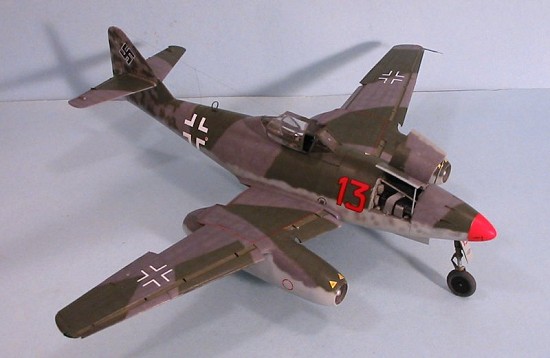 Busch spent the next month recovering from his injuries, which likely saved
his life, given the losses suffered by KG 51 during this period. He only
flew one combat mission, in late March, 1945. “We had gotten a call there
were Thunderbolts in the vicinity, and I was sent to intercept them. I got
off from Neuburg, and the base controller said the Americans were 20
kilometers east. I came out of the clouds and there they were! Four, on a
strafing mission. I saw the last one, flying straight and level, waiting
his turn. I came up behind, I had him dead-center in my gunsight, and I
pulled the trigger - nothing! I did it again - still nothing!” Without
operational armament, Busch knew the speed he’d built up diving on the
Americans could get him out of trouble, perhaps without being spotted.
“Just at the moment I was above him, that Thunderbolt pilot looked up and
saw me! All he had to do was maintain his position, and I would come around
in front of him and he could blast me. I couldn’t do a thing to him! But
he got scared and executed a split-ess. I pulled out and climbed toward
the field. When I called in, they said there were Thunderbolts overhead,
waiting for me. I stayed high to save fuel till ground control reported
they’d left, then landed without harm. It was my first and last combat in
an Me-262.” Upon landing, Busch and his mechanic discovered disconnected
electrical wiring had prevented firing the cannons. “The next week we were
ordered to turn our airplanes over to Galland’s JV44.”
Busch spent the next month recovering from his injuries, which likely saved
his life, given the losses suffered by KG 51 during this period. He only
flew one combat mission, in late March, 1945. “We had gotten a call there
were Thunderbolts in the vicinity, and I was sent to intercept them. I got
off from Neuburg, and the base controller said the Americans were 20
kilometers east. I came out of the clouds and there they were! Four, on a
strafing mission. I saw the last one, flying straight and level, waiting
his turn. I came up behind, I had him dead-center in my gunsight, and I
pulled the trigger - nothing! I did it again - still nothing!” Without
operational armament, Busch knew the speed he’d built up diving on the
Americans could get him out of trouble, perhaps without being spotted.
“Just at the moment I was above him, that Thunderbolt pilot looked up and
saw me! All he had to do was maintain his position, and I would come around
in front of him and he could blast me. I couldn’t do a thing to him! But
he got scared and executed a split-ess. I pulled out and climbed toward
the field. When I called in, they said there were Thunderbolts overhead,
waiting for me. I stayed high to save fuel till ground control reported
they’d left, then landed without harm. It was my first and last combat in
an Me-262.” Upon landing, Busch and his mechanic discovered disconnected
electrical wiring had prevented firing the cannons. “The next week we were
ordered to turn our airplanes over to Galland’s JV44.”
| THE KIT |
Read the review of what’s in the box here. (URL) The difference between the two kits is that the Me-262A-2a has a “Sprue H” which has the bombs and bomb racks for either the SC1000 or SC500 bombs. Decals for the bomber version include the well-known “Red B” of KG 51, and “Yellow G” of KG 54, the other Me-262 Jabo unit.
| CONSTRUCTION |
I
received the Me-262A-1a kit for review in early September, but put off
doing it until I obtained the new EagleCals decal sheet for Red-13, and
also got Jerry Rutman’s resin wheel sets. Fortunately, he sent me
both the smooth tread and the
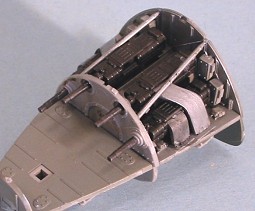 diamond tread wheels.
After getting the decals and wheels and just after starting in on the first
kit, the Me-262A-2a kit arrived. I decided that since I was now deep
into doing Me-262s, I would do both together, which is what happened.
diamond tread wheels.
After getting the decals and wheels and just after starting in on the first
kit, the Me-262A-2a kit arrived. I decided that since I was now deep
into doing Me-262s, I would do both together, which is what happened.
There are a lot of parts in the kits, but construction is simple if one commits the radical act of following the instructions.
Fit overall is very good, though if you are going to put things inside the fuselage, I recommend you sand the edges of the various bulkheads to make them slightly smaller. Otherwise, you do a lot of pushing and shoving to get the fuselage halves together. If you sand things down a bit, you will get away with not having to use anything on the centerline seams.
While I decided to drop the flaps as well as the slats and open the gunbay
on the Me-262A-1a, I decided to emphasize the sleek lines of the aircraft
with the Me-262A-2a, which was built with the flaps raised and the gunbay
closed, which - if you look at photos of the real thing - is the way most
Me-262s of either gender were seen on the ground. As regards the radio
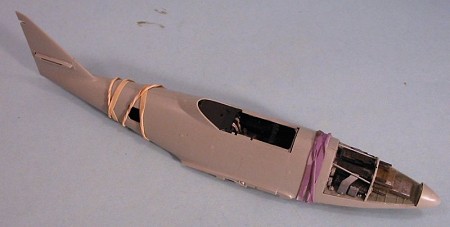 bay, you can open it and there is a plethora of detail that can be placed
in there, none of which can be seen if you aren’t a paid-up and
fully-equipped member of the Penlight Polizei.
bay, you can open it and there is a plethora of detail that can be placed
in there, none of which can be seen if you aren’t a paid-up and
fully-equipped member of the Penlight Polizei.
The same is true of the engines, which are models in themselves. If you open the forward nacelle cover, you can see a small bit of the engine, but the only way to see the entire thing is to use the clear plastic engine nacelles. After spending an hour to assemble one engine, and then realizing that once it was in the nacelle the only thing that would be visible was the exhaust and the intake, I limited my engine building to assembling the exhaust can with the adjustable cone for the rest. Not having the entire engine inside meant that the nacelles went together easily and only needed a very little bit of Mr. Surfacer to get rid of the centerline seam. Five minutes with a #11 X-acto blade and a pounce wheel restored the surface detail lost in sanding the seams smooth.
The RDF loop antenna is very delicate. I attached mine before painting on both models, and managed to break each during handling while painting. I suggest you do this the easy way and do not attach this antenna until the model is painted, decaled, and weathered.
Other than these items, the model goes together beautifully, and if you are careful in test-fitting parts, and then careful in fitting them together before you apply glue, you will nave no seams to fill and everything will go together smoothly.
Do not attach the slats permanently until after the model is painted.
You will nee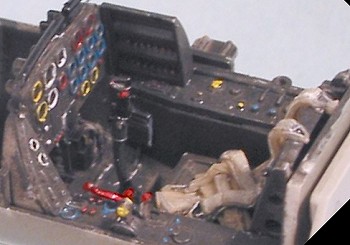 d to set
them in the closed position after you have painted the area beneath them
and the interior of the slats, before applying the camouflage color.
I found it was useful to attach them with masking tape for the side not
being painted, since they can easily fall out when the model is handled
during painting. I added at least two hours to the time spent on the
Me-262A-1a finding the inner right flap, which had fallen off during the
painting process, an event that turned the atmosphere of the entire
workroom a deep purple lit though with crackling lightning flashes.
d to set
them in the closed position after you have painted the area beneath them
and the interior of the slats, before applying the camouflage color.
I found it was useful to attach them with masking tape for the side not
being painted, since they can easily fall out when the model is handled
during painting. I added at least two hours to the time spent on the
Me-262A-1a finding the inner right flap, which had fallen off during the
painting process, an event that turned the atmosphere of the entire
workroom a deep purple lit though with crackling lightning flashes.
As regards the cockpits, I don’t really see a need for some $30 resin cockpit for these models, as the kit-supplied cockpit is quite accurate and complete. I did modify my kits by using some photo-etch rudder pedals I had left over from other projects. I also used the Cutting Edge posable resin seat belts on the Me-262A-1a, because I had the set available and like them. However, I used the kit-supplied photo-etch seatbelts for the Me-262A-2a, and they are more than adequate for giving the finished cockpit a good look.
| COLORS & MARKINGS |
Painting:
There are many models of these two allegedly well-known airplanes, and -
other than my 1/48 model of Red 13 (and this one) - I have yet to see two
done the same. This is particularly true of “Red B” - I know of at least
one other model of this airplane done from this kit on display at another
website, with a scheme unlike any I have ever seen for this airplane, and
there are three other models there of this airplane, each in a different
scheme. I chose to do a wave-mirror scheme close to
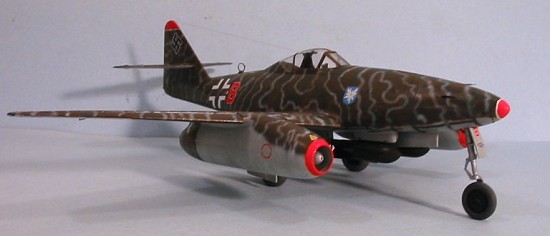 what is shown in the
color diagram in the kit, since this is also close to the wave-mirror
scheme shown in other photos of KG 51 Sturmvogels. Since it is clear that
no one appears to know with certainty what the scheme was for this
airplane, I also decided to go with an unpainted natural metal finish for
the lower surface of the fuselage and the wings, since this is known to be
right for “Black X,” which was in the same unit; this also allowed me to do
the putty in the panel lines, which I hadn’t done with an Me-262 before.
But mostly it made this model definitely different from the other one.
what is shown in the
color diagram in the kit, since this is also close to the wave-mirror
scheme shown in other photos of KG 51 Sturmvogels. Since it is clear that
no one appears to know with certainty what the scheme was for this
airplane, I also decided to go with an unpainted natural metal finish for
the lower surface of the fuselage and the wings, since this is known to be
right for “Black X,” which was in the same unit; this also allowed me to do
the putty in the panel lines, which I hadn’t done with an Me-262 before.
But mostly it made this model definitely different from the other one.
For Red-13, Jerry Crandall makes note in the instruction sheet that a modeler could do the airplane in 81/82/76, 81/83/76,82/83/76, or 74/75/76. He then points out that a color photo of White 17 of EJG2, in the same serial range as this airplane, shows the airplane definitely painted in 74/75/76. Since the available black and white shots of Red 13 show a pretty strong contrast difference between the darker and lighter upper surface colors, much like other black and white photos of other airplanes painted 74/75 on their upper surfaces, I think I am on strong ground in choosing the early scheme, although a case could be made for 82/83.
I used Xtracrylix paints for both of these models.
Painting the Me-262A-1a:
After painting the wheel wells RLM02 and stuffing them with Kleenex, I pre-shaded the model with flat black airbrushed over all the panel lines that would have been puttied.
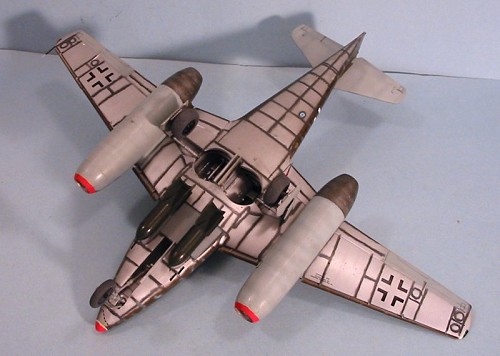 The entire standard Me-262 dayfighter camouflage pattern was done freehand
with my Paasche-H airbrush.
The entire standard Me-262 dayfighter camouflage pattern was done freehand
with my Paasche-H airbrush.
The undersides were painted with Xtracrylix RLM76 Hellblau, lightened with white for a second coat to emphasize the panel lines that had been puttied.
The upper surface was painted with RLM74 Grau-Grun and RLM75 Grauviolett, each again lightened with white for a second coat to subtly bring up the puttied panel lines.
Painting the Me-262A-2a:
In painting the Me-262A-2a, I started by painting the lower surfaces and the area of the upper wing under the slats with SNJ “Aluminum.” I then painted several different panels with Alclad II “Duraluminum,” which gave different contrasts.
When that was dry, I “pre-shaded” the model with Xtracrylix RAF Dark Sea Grey, which was a close color to the grey of the putty used on the airframe. I then painted the lower surfaces of the horizontal stabilizers and elevators, the ailerons, and the engine nacelles, with RLM76 Hellblau, lightening it with white after the initial coat and going back over it to emphasize the panel lines that would have had the dark grey putty, since it seems this color came through the paint frequently.
For the upper surface, I decided to do it in RLM81 Braunviolett overall, with RLM82 Dunkelgrun blotches, and a wave-mirror pattern done in a “scribble” of RLM76. I found some color photos of Me-262s in the 81/82 scheme, and realized that the Braunviolett was new enough that it had the look of US Olive Drab that is described - several “expert modelers” have looked at these same photos and decided the colors are 82/83, but the lighter color is too dark and too olive to be the bright green known as RLM83 Lichtgrun, so I think it must be new RLM81. At any rate, that’s my story and I’m sticking to it as to why I chose the colors I did.
I used Xtracrylix “Olive Drab” for the RLM81, lightening it with some Xtracrylix RLM81 which is decidedly brown, to go back over it and emphasize the panel lines. I then applied blotches of RLM82 Dunkelgrun. The “wave-mirror” pattern was intentionally done unevenly, since every photo of an airplane done in this scheme shows the “scribble” to be very messy and uneven - likely it was applied by more than one junior “black man” armed with a spray gun, tightened to different settings.
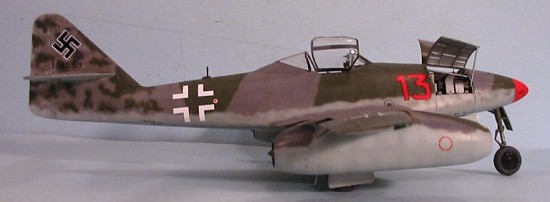 The red is Xtracrylix Red23, and was hand-brushed, which is the way it
would have been applied for real. Since Xtracrylix can be hand-brushed for
a very nice coat - unlike nearly every other acrylic paint - I took
advantage of that fact to add a note of realism.
The red is Xtracrylix Red23, and was hand-brushed, which is the way it
would have been applied for real. Since Xtracrylix can be hand-brushed for
a very nice coat - unlike nearly every other acrylic paint - I took
advantage of that fact to add a note of realism.
Decals:
Once both models had been Futured, it was time for decals. I used the kit-supplied stencil decals for both models, and the kit-supplied markings for the Me-262A-2a. These went on with no problem. The EagleCals sheet was used for the national markings and personal markings of Red-13, and also went on with no problems, using Micro-Sol.
Both models then received a coat of Xtracrylix Satin Varnish after being washed to get rid of decal solvent residue.
| FINAL CONSTRUCTION |
Neither of these airplanes were flown on extended operations. According to both Jorg Czypionka and Hans Busch, the Me-262s were kept well-maintained by the ground crews and always looked quite clean during the few months they were operational. With that in mind, I decided to minimize weathering to some aluminum dry-brushing of the cockpits to pop out detail and simulate the dings that would come from operating the controls. The airframes were otherwise kept clean.
Each model received to coats of Xtracrylix Flat Varnish, which does not give a “dead flat” finish and is accurate for the flat finish of airplanes that haven’t been subject to sun fading of the paint.
I then attached the landing gear. The Me-262A-1a got the smooth-tread wheels, while the Me-262A-2a received the diamond-tread wheels. I also glued the slats in the down position on both models at this point, and attached the flaps in the down position on the Me-262A-1a. I finished off the Me-262A-1a by attaching the gun bay covers, and then unmasked the canopies for both. I didn’t use the head armor for the Me-262A-1a, since it is recorded that Heinz Bar removed this to improve all-round visibility.
| CONCLUSIONS |
These Me-262 kits from Trumpeter are head and shoulders above any other kits of the airplane done in any scale. The surface detail is delicate and accurate. The separate control surfaces are excellent, and this is one of the few kits I have found where posing the separated flaps in the raised position is not difficult.
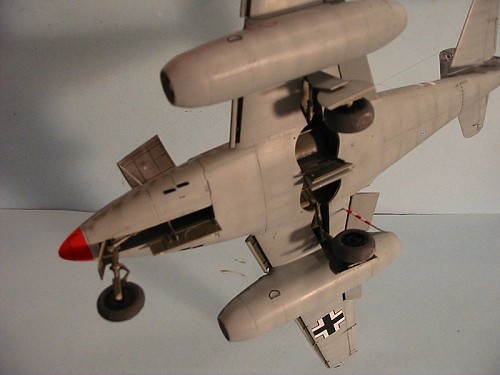 For me, the arrival of the TBF/TBM Avenger kits demonstrated that Trumpeter
could “get it right.” The Me-262 is proof the Avengers weren’t a fluke.
Watch out, Hasegawa and Tamiya! At the suggested sale price, the kit is one
of the best overall bargains around - the only thing a modeler will want to
get from the aftermarket folks are decals, and I predict there will soon be
a plethora of 1/32 Me-262 decals available.
For me, the arrival of the TBF/TBM Avenger kits demonstrated that Trumpeter
could “get it right.” The Me-262 is proof the Avengers weren’t a fluke.
Watch out, Hasegawa and Tamiya! At the suggested sale price, the kit is one
of the best overall bargains around - the only thing a modeler will want to
get from the aftermarket folks are decals, and I predict there will soon be
a plethora of 1/32 Me-262 decals available.
I do recommend Jerry Rutman’s resin wheels, because they are a real improvement over the rubber wheels in the kit. Jerry also does a really nice set of under wing racks and R4M rockets that were used on some Me-262s in the final weeks of the war, and aren’t provided in the kit. I would have used the rockets on my Me-262A-1a, but photos show Red-13 never carried them.
I am going to go out on a limb and say I expect these Me-262s will become the most popular 1/32 scale kits released to date. If you have yet to do a 1/32 kit and you like the Me-262, what are you waiting for? It’s a beautiful kit that provides a fun build and a superb model at the end.
November 2005
Review kits courtesy of Stevens International. Decal sheet courtesy of EagleCals. Wheels courtesy of Jerry Rutman.
If you would like your product reviewed fairly and quickly by a site that has around 300,000 visitors a month, please contact me or see other details in the Note to Contributors.